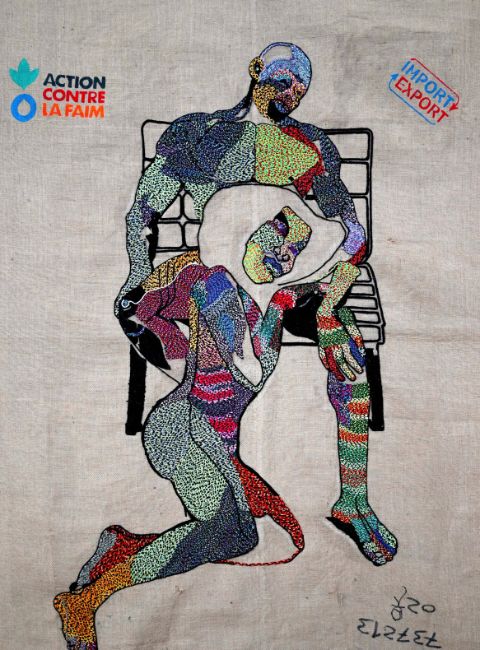Aristote Mago

Entre Coupe © VG Bild-Kunst, Bonn 2023. Photo: kin artstudio
Born in Kinshasa, one of the most vibrant cities of the African continent, Aristote Mago, like many other Kinois, has been strongly influenced by the culture of débrouillardise—a term that describes creativity and innovation as acts of survival in a fast-evolving city. Mago has developed a practice that layers histories and memories against urgent sociopolitical questions. His technique of recuperation and use of found materials follows a long tradition of art making that emerged in the 1960s in both western and central parts of the African continent. Such an approach was not only a reaction to the lack of available materials used elsewhere in modern artistic practice but also a way of countering the ever-growing consumerist dimensions of art making. Sacks made from jute, a natural fibre, as well as those made of polypropylene are Mago’s canvases of choice. Both materials hold a long history of trade and transportation of mass-produced goods such as coffee, bananas, yams, charcoal, and sugar, among others. Through superimposed stitching, the artist depicts scenes of everyday life, centring social and political themes such as land exploitation and the climate crisis, sexuality and queerness, and democracy and free expression.
Commissioned by Haus der Kulturen der Welt (HKW), co-produced by Aristote Mago and HKW, 2023.
Works in the exhibition: Entre Coupe (2023), painting, mixed media collage synthetic cotton thread, lace on jute canvas, 199 × 150 cm; Elombe (2023), painting, mixed media collage synthetic cotton thread, lace on jute canvas, 199 × 150 cm; Empereur (2023), painting, mixed media collage synthetic cotton thread, lace on jute canvas, 150 × 149 cm; Untitled (2023), painting, mixed media collage, synthetic cotton thread, lace on jute canvas, 150 × 149 cm. Courtesy of the artist